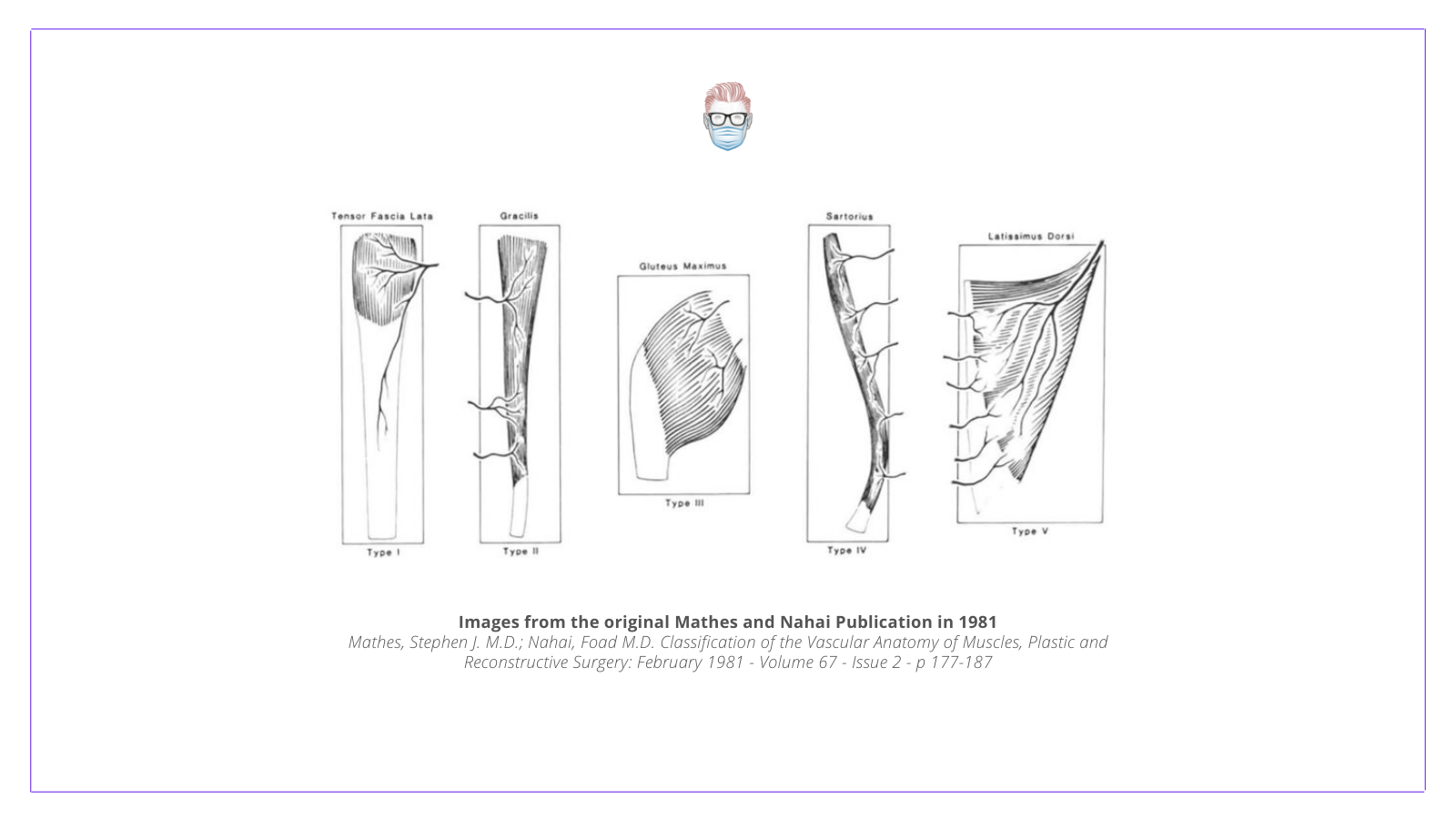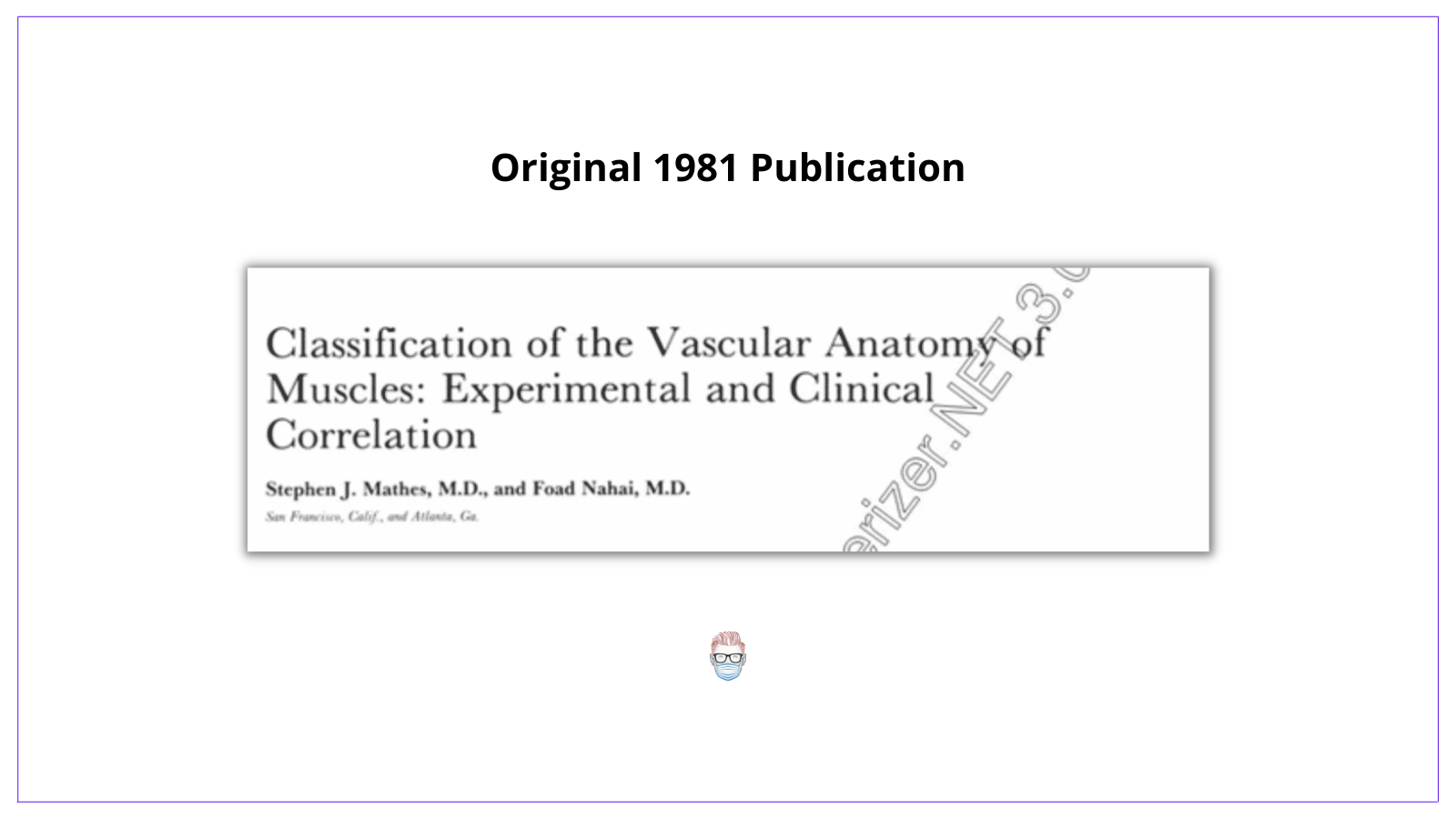Summary Card
Origin and Publication
The Mathes and Nahai Classification was introduced as a way of describing the blood supply to muscle and musculocutaneous flaps.
Mathes and Nahai Classification
Mathes and Nahai classification describes the number of major & minor pedicles of a muscle flap.
Origin of Mathes and Nahai Classification
The Mathes and Nahai Classification was introduced as a way of describing the blood supply to muscle and musculocutaneous flaps.
The Mathes and Nahai Classification system was first described in 1981 as a way of describing the blood supply to muscle and musculocutaneous flaps. It was first described by Mathes and Nahai in a 1981 PRS publication.
This classification is illustrated in the image below.

There are some important points for context:
- There is no commonly used alternative classification for muscle flaps.
- It does not relate to local flaps, such as rotation or rhomboid flaps, only muscle.
- It is different from Mathe and Nahai's fasciocutaneous flap classification.
- Blood supply to muscles and musculocutaneous flaps can be read here.

Mathes and Nahai Classification
Mathes and Nahai classification describes the number of major & minor pedicles of a muscle flap.
The Mathes and Nahai classification for muscle flaps can be visualised in the image below.

Key points on the Mathes and Nahai classification system are:
- Type 1: 1 major pedicle (gastrocnemius)
- Type 2: 1 major and 1 minor pedicle (gracilis flap)
- Type 3: 2 major pedicles (rectus abdominis)
- Type 4: Minor segmental pedicles (sartorius)
- Type 5: 1 major and minor segmental pedicles (latissimus dorsi flap)
These types are illustrated in the diagram below.

A mnemonic for Mathes and Nahai Classification is as follows: Ten Graceful Glutes Sat on Latrines.
- Type I: TFL flap
- Type II: Gracilis flap
- Type III: Gluteus maximus flap, VRAM flap
- Type IV: Sartorius flap
- Type V: Lattisimus dorsi flap
Another mnemonic for Muscles flaps is: "Get Good Remembering Supply Lines" ·
- Type 1: Gastrocnemius
- Type 2: Gracilis
- Type 3: Rectus abdominis
- Type 4: Sartorius
- Type 5: Latissumus dorsi
Conclusion
1. Mathes and Nahai Classification: Gained a detailed understanding of the Mathes and Nahai classification system which describes the vascular supply to muscle and musculocutaneous flaps based on the number and type of vascular pedicles.
2. Classification: Learned the specific types of vascular pedicles that categorize muscle flaps into five different types, enhancing your ability to plan reconstructive surgeries with appropriate flaps.
3. Application in Clinical Practice: Appreciated the relevance of this classification in clinical practice, particularly in reconstructive surgery, to ensure optimal flap survival and functional outcomes.
4. Differentiation of Flap Types: Distinguished between different types of muscle flaps based on their vascular anatomy, which is critical for surgical planning and execution.
References
- Classification of the vascular anatomy of muscles: experimental and clinical correlation. Mathes SJ, Nahai F. Plast Reconstr Surg. 1981 Feb;67(2):177-87.
- A Practical Guide to Free Tissue Transfer. Roehl, Kendall R. M.D et al. Plastic and Reconstructive Surgery: July 2013 – Volume 132 – Issue 1 – p 147e–158e doi: 10.1097/PRS.0b013e3182910fba
- The Concepts of Propeller, Perforator, Keystone, and Other Local Flaps and Their Role in the Evolution of Reconstruction. Mohan, Anita T et al. Plastic and Reconstructive Surgery: October 2016 – Volume 138 – Issue 4 – p 710e-729edoi: 10.1097/PRS.0000000000002610
- Advances in muscle and musculocutaneous flaps. Mathes SJ, Alpert BS. Clin Plast Surg. 1980 Jan;7(1):15-26.


